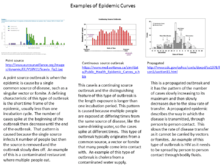Outbreak
In epidemiology, an outbreak is a sudden increase in occurrences of a disease in a particular time and place. It may affect a small and localized group or impact upon thousands of people across an entire continent. Two linked cases of a rare infectious disease may be sufficient to constitute an outbreak. Outbreaks include epidemics, which term is normally only used for infectious diseases, as well as diseases with an environmental origin, such as a water or foodborne disease. They may affect a region in a country or a group of countries. Pandemics are near-global disease outbreaks.
Outbreak investigation
When investigating disease outbreaks, the epidemiology profession has developed a number of widely accepted steps. As described by the United States Centers for Disease Control and Prevention, these include the following:[1]
- Identify the existence of the outbreak (Is the group of ill persons normal for the time of year, geographic area, etc.?)
- Verify the diagnosis related to the outbreak
- Create a case definition to define who/what is included as a case
- Map the spread of the outbreak using Information technology as diagnosis is reported to insurance
- Develop a hypothesis (What appears to be causing the outbreak?)
- Study hypotheses (collect data and perform analysis)
- Refine hypothesis and carry out further study
- Develop and implement control and prevention systems
- Release findings to greater communities
The order of the above steps and relative amount of effort and resources used in each varies from outbreak to outbreak. For example, prevention and control measures are usually implemented very early in the investigation, often before the causative agent is known. In many situations, promoting good hygiene and hand-washing is one of the first things recommended. Other interventions may be added as the investigation moves forward and more information is obtained. Waiting until the end of an investigation to implement prevention and control measures is a sure way to lose ones job. In outbreaks identified through notifiable disease surveillance, reports are often linked to laboratory results and verifying the diagnosis is straight forward. In outbreaks of unknown etiology, determining and verifying the diagnosis can be a significant part of the investigation with respect to time and resources. Several steps are usually going on at any point in time during the investigation. Steps may be repeated. For example, initial case definitions are often established to be intentionally broad but later refined as more is learned about the outbreak. The above list has 9 steps, others have more. Implementing active surveillance to identify additional cases is often added. [2]
Outbreak debriefing and review has also been recognized as an additional final step and iterative process by the Public Health Agency of Canada.[3]
Types

There are several outbreak patterns, which can be useful in identifying the transmission method or source, and predicting the future rate of infection. Each has a distinctive epidemic curve, or histogram of case infections and deaths.[4]
- Common source – All victims acquire the infection from the same source (e.g. a contaminated water supply).[5]
- Continuous source – Common source outbreak where the exposure occurs over multiple incubation periods
- Point source – Common source outbreak where the exposure occurs in less than one incubation period[6]
- Propagated – Transmission occurs from person to person.[7]
Outbreaks can also be:
- Behavioral risk related (e.g., sexually transmitted diseases, increased risk due to malnutrition)[8]
- Zoonotic – The infectious agent is endemic to an animal population.
Patterns of occurrence are:
- Endemic – a communicable disease, such as influenza, measles, mumps, pneumonia, colds, smallpox, which is characteristic of a particular place, or among a particular group, or area of interest or activity.
- Epidemic – when this disease is found to infect a significantly larger number of people at the same time than is common at that time, and among that population, and may spread through one or several communities.
- Pandemic – occurs when an epidemic spreads worldwide.
Outbreak legislation
Outbreak legislation is still in its infancy and not many countries have had a direct and complete set of the provisions.[9][10] However, some countries do manage the outbreaks using relevant acts, such as public health law.[11]
See also
- 1947 New York City smallpox outbreak
- 1993 Four Corners hantavirus outbreak
- 2003 Midwest monkeypox outbreak
- 2007 Yap Islands zika virus outbreak
- 2014 Democratic Republic of the Congo Ebola virus outbreak
- Super-spreader
References
- ↑ Steps of an Outbreak Investigation, EXCITE | Epidemiology in the Classroom | Outbreak Steps
- ↑ "Principles of Epidemiology in Public Health Practice" (PDF). Centers for Disease Control and Prevention. CDC. Retrieved 6 August 2016.
- ↑ Public Health Agency of Canada. "Canada's Food-borne Illness Outbreak Response Protocol (FIORP) 2010: To guide a multi-jurisdictional response". Retrieved 22 March 2013.
- ↑ Archived March 19, 2009, at the Wayback Machine.
- ↑ Glossary of Epidemiology Terms, Cdc.gov (2007-04-25). Retrieved on 2010-11-25.
- ↑ Glossary of Epidemiology Terms. Cdc.gov (2007-04-25). Retrieved on 2010-11-25.
- ↑ Glossary of Epidemiology Terms. Cdc.gov (2007-04-25). Retrieved on 2010-11-25.
- ↑ Archived September 28, 2008, at the Wayback Machine.
- ↑ "Bioterrorism Training and Curriculum Development Program". Retrieved 2 August 2008.
- ↑ Star Publications. "'Outbreak actions protected by law'". Retrieved 2 August 2008.
- ↑ The State of Queensland Government. "Legislation and Powers of Entry". Retrieved 2 August 2008.
External links
| Look up outbreak in Wiktionary, the free dictionary. |